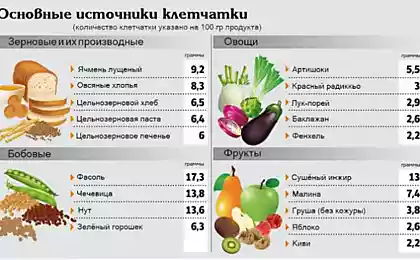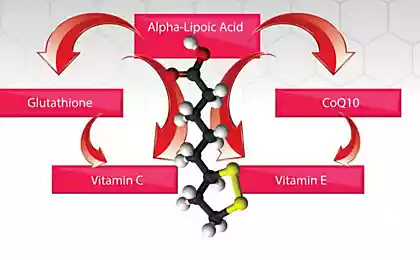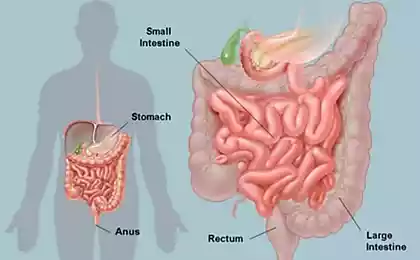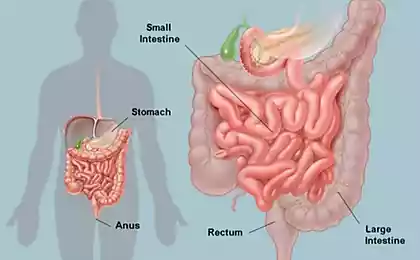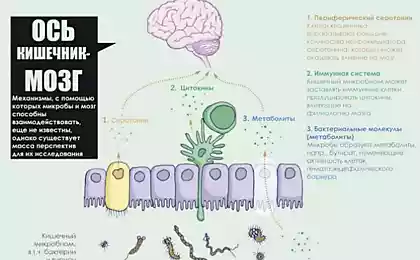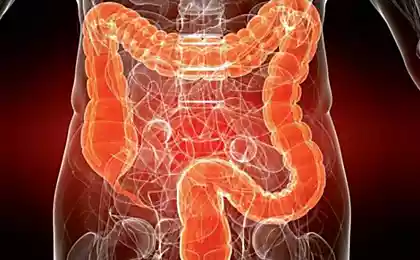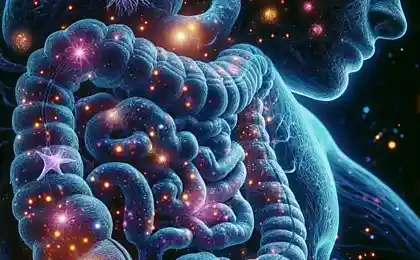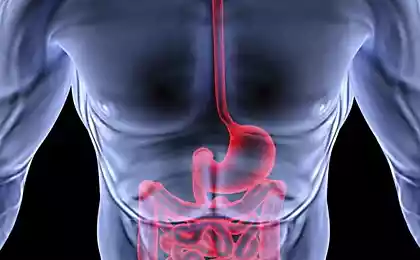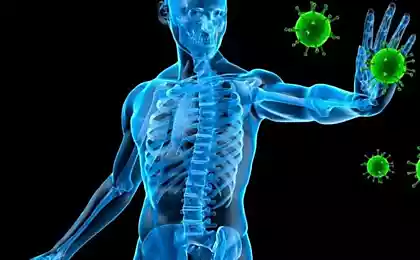502
Cellulose and propionic acid in Your gut
Propionic acid is one of the three major short chain fatty acids, along with the oil and vinegar. Propionic acid is transported to the liver and included in the process of gluconeogenesis, and acetate enters the tissue as an energy substrate.
Acetic acid is formed during fermentation of undigested carbohydrates in the colon and is rapidly absorbed into the blood. From 50 to 70% of the absorbed acetic acid is absorbed the liver — the remainder enters the peripheral circulation and, ultimately, it is metabolized in the peripheral tissues, particularly muscle, as a source of energy. Acetic acid is the primary substrate for cholesterol synthesis, so necessary for neuronal and hormonal anabolism.
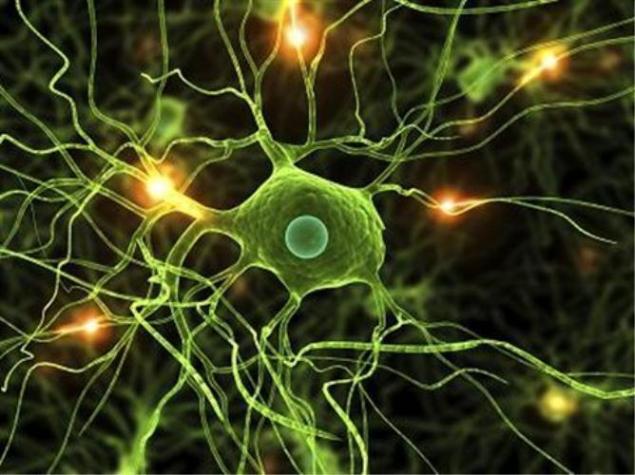
Propionic acid, like vinegar, are also primarily absorbed by the liver. However, she is playing a completely different metabolic role. Namely:
— reduces the synthesis of cholesterol, but also reduces its metabolic rate so that the amount of cholesterol in the blood increasing and triglycerides;
— reduces the content of fatty acids in liver and blood plasma;
— increases sensitivity to insulin;
— reduces appetite;
— used for gluconeogenesis;
is an immunosuppressant (which can be both good and bad);
— has a positive effect on inflammation, increasing the threshold of inflammation in General;- causes a feeling of satiety. Propionic acid fermentation is a continuation of the lactic fermentation, fermented lactic acid, the end product becomes slightly acidic. The propionic acid bacteria: — inhibit the activity of putrefactive fungi and pathogenic fungi,
— form vitamins and lots of vitamin B12,
— some strains cause growth inhibition of cancer cells,
— provide protection against intestinal infection.
In addition, propionic acid bacteria are not digested in the gastrointestinal tract of humans resistant to the action of bile acids and vyderzhivayut low (pH 2.0) the acidity of the stomach. Propionic bacteria stimulate the growth of faecal bifidobacteria and help in the treatment of bacterial dysbiosis. The main habitat of the classical propionic acid bacteria — hard rennet cheeses. There are also data on the allocation of a number of bacterial species from soil and fermenting olive. These bacteria are commonly found in the stomach of ruminants, and, in part, because of their activities of Swiss cheese has its own flavor. Cheese-making is the most ancient biotechnology, using biochemical activity of propionic bacteria. The first studies on propionic acid bacteria have been associated with the study of their role in the ripening of cheese. The highest organoleptic properties and prolonged shelf life have a hard rennet cheese with high temperature second heating, the production of which involved the propionic acid bacteria. Strains of propionic acid bacteria of the species Propionibacterium freudenreichii is widely used in food industry for fermentation of dairy products. Emmental cheese and other varieties of Swiss cheese are fermented milk in two steps: in the first the lactose, and other carbohydrates are fermented with lactic acid bacteria to lactic acid, the second — lactic acid using propionic acid bacteria are transformed into propionic acid and carbon dioxide (forming "holes" in Swiss cheese). Probiotic properties of propionic acid bacteria associated with:
— formation of useful metabolites and antimicrobial components;
antimutagenic properties;
they serve as a source of 3-galactosidase — an enzyme that breaks down lactose;
— promote the growth of bifidobacteria;
form significant quantities of low-calorie, sugar — trehalose.
Their biomass contains minerals in the amount (MD/kg): MP (267), C (102), Fe (535), higher than their content in the biomass of bifidobacteria and dairy. It is proved that the propionic acid bacteria reduce the activity of enzymes of the p-glucoronidase, nitroreductase and azoreductase, under the action of which fecal procancerogenic converted into the active forms of carcinogens. They form and accumulate when NO restoring of nitrate and nitrite. Nitric oxide is important for many vital functions, such as neurotransmission, vasodilation, intestinal motility, protection of the mucous membrane. Chronic intestinal disorders can be associated with insufficient formation of NO in the body.
Demonstrated antimutagenic activity of propionic acid bacteria against point mutations. Given the fact that many of the foods we commonly eat contain some amount of mutagens (especially when broiling food, eat moldy food), antimutagenic properties of propionic acid bacteria is difficult to overestimate. Propionic acid bacteria form and produce bifidogenic metabolites contributing to the growth of several strains of bifidobacteria. This influence mutually. While observational studies have discovered that propionic acid is toxic, mutagenic, carcinogenic and adversely affects the reproductive organs. In the body, propionic acid is rapidly oxidized, metaboliziruet and excreted as carbon dioxide in the Krebs cycle, do not accumulate in the body. Especially a lot of propionic bacteria is formed in foods that have undergone a long fermentation in a cool environment. For example, the fermentation in the cellar or the fridge. In a short period of fermentation, the products will little propionic bacteria. The number of species of Propionibacterium are capable of producing vitamin B12. This quality propionibacteria used in the manufacture of vitamins. Propionic bacteria can synthesize all amino acids due to the assimilation of nitrogen (NH4)2SO4. The protein biosynthesis of propionic bacteria is accompanied by the creation of a pool of 15 amino acids: cystine, histidine, arginine, aspartate, glutamic acid, glycine, serine, threonine, β-alanine, tyrosine, valine, methionine, Proline, phenylalanine and leucine. It is known that bacteria contain peptidases which participated provide themselves with essential amino acids, and the reaction of transamination, can grow on any of the 20 amino acids included in the medium as the sole source of nitrogen.
In order to ensure the intestinal propionic acid, you need to follow only three simple rules:
1.Often: eat foods containing soluble fiber and resistant starches.
2. Sometimes fermented foods, sodomisee bacteria.
3.Do not get carried away "is enriched with lactobacilli".
What foods contain gluten?
First of all, legumes, vegetables, fruits, nuts, whole grain cereals. Animal food tissue is substantially free. Give preference to soluble fiber.
Foods containing soluble fiber (per 100g):
Author Andrew Blueskin
P. S. And remember, only by changing their consumption — together we change the world! ©
Join us in Facebook , Vkontakte, Odnoklassniki
Source: www.beloveshkin.com/2015/03/kletchatka-i-propionovaya-kislota-v-vashem-kishechnike.html
Acetic acid is formed during fermentation of undigested carbohydrates in the colon and is rapidly absorbed into the blood. From 50 to 70% of the absorbed acetic acid is absorbed the liver — the remainder enters the peripheral circulation and, ultimately, it is metabolized in the peripheral tissues, particularly muscle, as a source of energy. Acetic acid is the primary substrate for cholesterol synthesis, so necessary for neuronal and hormonal anabolism.

Propionic acid, like vinegar, are also primarily absorbed by the liver. However, she is playing a completely different metabolic role. Namely:
— reduces the synthesis of cholesterol, but also reduces its metabolic rate so that the amount of cholesterol in the blood increasing and triglycerides;
— reduces the content of fatty acids in liver and blood plasma;
— increases sensitivity to insulin;
— reduces appetite;
— used for gluconeogenesis;
is an immunosuppressant (which can be both good and bad);
— has a positive effect on inflammation, increasing the threshold of inflammation in General;- causes a feeling of satiety. Propionic acid fermentation is a continuation of the lactic fermentation, fermented lactic acid, the end product becomes slightly acidic. The propionic acid bacteria: — inhibit the activity of putrefactive fungi and pathogenic fungi,
— form vitamins and lots of vitamin B12,
— some strains cause growth inhibition of cancer cells,
— provide protection against intestinal infection.
In addition, propionic acid bacteria are not digested in the gastrointestinal tract of humans resistant to the action of bile acids and vyderzhivayut low (pH 2.0) the acidity of the stomach. Propionic bacteria stimulate the growth of faecal bifidobacteria and help in the treatment of bacterial dysbiosis. The main habitat of the classical propionic acid bacteria — hard rennet cheeses. There are also data on the allocation of a number of bacterial species from soil and fermenting olive. These bacteria are commonly found in the stomach of ruminants, and, in part, because of their activities of Swiss cheese has its own flavor. Cheese-making is the most ancient biotechnology, using biochemical activity of propionic bacteria. The first studies on propionic acid bacteria have been associated with the study of their role in the ripening of cheese. The highest organoleptic properties and prolonged shelf life have a hard rennet cheese with high temperature second heating, the production of which involved the propionic acid bacteria. Strains of propionic acid bacteria of the species Propionibacterium freudenreichii is widely used in food industry for fermentation of dairy products. Emmental cheese and other varieties of Swiss cheese are fermented milk in two steps: in the first the lactose, and other carbohydrates are fermented with lactic acid bacteria to lactic acid, the second — lactic acid using propionic acid bacteria are transformed into propionic acid and carbon dioxide (forming "holes" in Swiss cheese). Probiotic properties of propionic acid bacteria associated with:
— formation of useful metabolites and antimicrobial components;
antimutagenic properties;
they serve as a source of 3-galactosidase — an enzyme that breaks down lactose;
— promote the growth of bifidobacteria;
form significant quantities of low-calorie, sugar — trehalose.
Their biomass contains minerals in the amount (MD/kg): MP (267), C (102), Fe (535), higher than their content in the biomass of bifidobacteria and dairy. It is proved that the propionic acid bacteria reduce the activity of enzymes of the p-glucoronidase, nitroreductase and azoreductase, under the action of which fecal procancerogenic converted into the active forms of carcinogens. They form and accumulate when NO restoring of nitrate and nitrite. Nitric oxide is important for many vital functions, such as neurotransmission, vasodilation, intestinal motility, protection of the mucous membrane. Chronic intestinal disorders can be associated with insufficient formation of NO in the body.
Demonstrated antimutagenic activity of propionic acid bacteria against point mutations. Given the fact that many of the foods we commonly eat contain some amount of mutagens (especially when broiling food, eat moldy food), antimutagenic properties of propionic acid bacteria is difficult to overestimate. Propionic acid bacteria form and produce bifidogenic metabolites contributing to the growth of several strains of bifidobacteria. This influence mutually. While observational studies have discovered that propionic acid is toxic, mutagenic, carcinogenic and adversely affects the reproductive organs. In the body, propionic acid is rapidly oxidized, metaboliziruet and excreted as carbon dioxide in the Krebs cycle, do not accumulate in the body. Especially a lot of propionic bacteria is formed in foods that have undergone a long fermentation in a cool environment. For example, the fermentation in the cellar or the fridge. In a short period of fermentation, the products will little propionic bacteria. The number of species of Propionibacterium are capable of producing vitamin B12. This quality propionibacteria used in the manufacture of vitamins. Propionic bacteria can synthesize all amino acids due to the assimilation of nitrogen (NH4)2SO4. The protein biosynthesis of propionic bacteria is accompanied by the creation of a pool of 15 amino acids: cystine, histidine, arginine, aspartate, glutamic acid, glycine, serine, threonine, β-alanine, tyrosine, valine, methionine, Proline, phenylalanine and leucine. It is known that bacteria contain peptidases which participated provide themselves with essential amino acids, and the reaction of transamination, can grow on any of the 20 amino acids included in the medium as the sole source of nitrogen.
In order to ensure the intestinal propionic acid, you need to follow only three simple rules:
1.Often: eat foods containing soluble fiber and resistant starches.
2. Sometimes fermented foods, sodomisee bacteria.
3.Do not get carried away "is enriched with lactobacilli".
What foods contain gluten?
First of all, legumes, vegetables, fruits, nuts, whole grain cereals. Animal food tissue is substantially free. Give preference to soluble fiber.
Foods containing soluble fiber (per 100g):
- rich in pectin (1-1,1 g) apples, black currants, beets
- moderate amounts of pectin (0,9-0,7 g) is found in plums, peaches, apricots, cranberries, strawberries, gooseberries;
- a small amount of pectin (0,6-0,5 g) is contained in cabbage, carrots, potatoes, pears, oranges, raspberries, grapes, lemons, watermelons;
- a small amount of pectin (about 0.4-0.3 g) eggplant, bulb onions, cucumbers, tomatoes, pumpkin, melon, tangerine, cherry, sweet cherry.
- foods rich in fiber is unrefined, raw products, which need to improve in the daily menu;
- the longer the heat treatment, the less fiber and resistant starches;
- give preference to whole foods;
- note the beans, cook them correctly;
- do not clean the fruit from the rind that it contains a lot of fiber;
- try to eat more fresh fruits and vegetables, not subjected to heat treatment;
- sometimes chilled, healthier hot, because of the higher content of resistant starches.published
Author Andrew Blueskin
P. S. And remember, only by changing their consumption — together we change the world! ©
Join us in Facebook , Vkontakte, Odnoklassniki
Source: www.beloveshkin.com/2015/03/kletchatka-i-propionovaya-kislota-v-vashem-kishechnike.html

